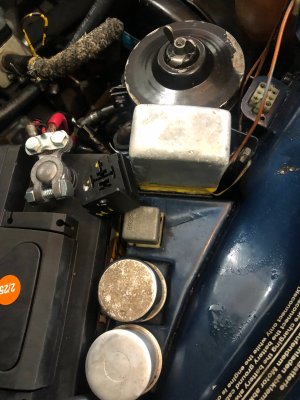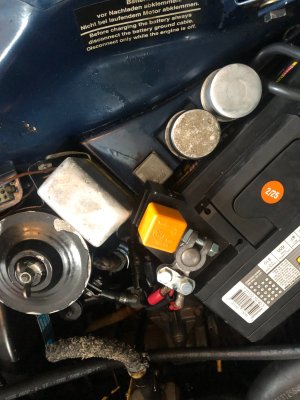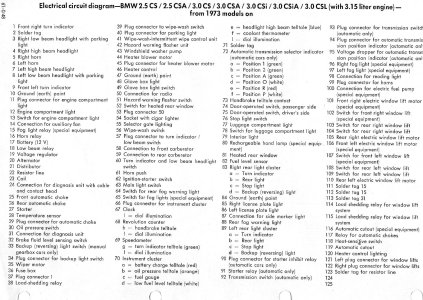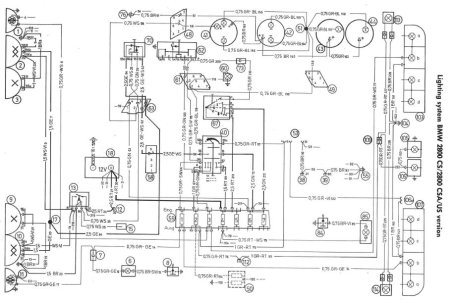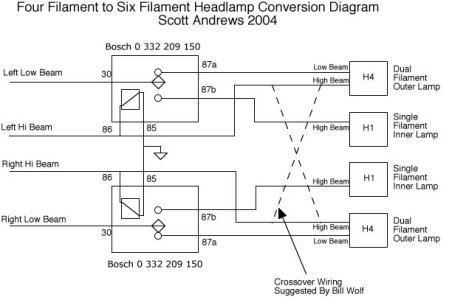I have spent too many hours with my mechanic at this point working on this (getting very expensive at this point) and need some help from the board. My mechanic is usually very talented and great at diagnosing electrical issues, but this has him stumped too after a lot of sorting, rewiring and troubleshooting. I'll try and explain this as best as possible, electronics is definitely my weak point so bear with me. See attached pics as well of what I am referring too. I also included the 1974 wiring diagram and legend we were using. On that subject, why is there no "high beam relay" in the legend?
What is happening is, if I don't plug in the orange relay (see pics of it in and out of connection), the low beams work as they should (I call it the central position, normal driving position for the H4/Low beam) and that is where I have it now so I am not high beaming people. If I plug the relay in, all four headlamps light up as if the switch for the head lamps is in the forward position for high beam, but this happens in the central position with relay in. If I pull back as if I were to flash someone with the headlamps it switches to low beam only. I hope I am explaining this right. Sorry if confusing. Normal driving with low beam only should only be the "Outside lights, correct with the H4 that can go from low to high beam. Then high beam the H4 goes to high beam and the center lights (H1's) are only high beam.
If this helps, some background info, when I bought the car the headlamps didn't work and the wires were melted as if improper ground or something. We checked the grounds, relays work, all the lights work and were rewired when installing the H1/H4's, just not as they should. All the lights in the rear work, the little light in the engine bay works and side markers all work. I don't think a simple fuse or none of the lights would work. We looked at the wiring under steering column to the switch and it looks like someone in the past poked the wires and maybe this issue was going on for a while and not properly diagnosed/fixed. The yellow, white and yellow/white wires all look to be in correct positions. The relay in the fuse box area, interior of car works. So, it has been very frustrating. The melted wires were all replaced with new ones, even heavier gauge (I think) so we are scratching our heads at this point.
I pulled the wiring diagrams and legend off of this thread: https://e9coupe.com/forum/threads/wiring-diagram-late-73-75-e9s.22639/
I have a US Spec 1974 3.0CS.
Thanks for any help in advance and if you need more clarity on the issue I will try and explain in more detail. I refer to the issue as being Bass-Akwards -S
What is happening is, if I don't plug in the orange relay (see pics of it in and out of connection), the low beams work as they should (I call it the central position, normal driving position for the H4/Low beam) and that is where I have it now so I am not high beaming people. If I plug the relay in, all four headlamps light up as if the switch for the head lamps is in the forward position for high beam, but this happens in the central position with relay in. If I pull back as if I were to flash someone with the headlamps it switches to low beam only. I hope I am explaining this right. Sorry if confusing. Normal driving with low beam only should only be the "Outside lights, correct with the H4 that can go from low to high beam. Then high beam the H4 goes to high beam and the center lights (H1's) are only high beam.
If this helps, some background info, when I bought the car the headlamps didn't work and the wires were melted as if improper ground or something. We checked the grounds, relays work, all the lights work and were rewired when installing the H1/H4's, just not as they should. All the lights in the rear work, the little light in the engine bay works and side markers all work. I don't think a simple fuse or none of the lights would work. We looked at the wiring under steering column to the switch and it looks like someone in the past poked the wires and maybe this issue was going on for a while and not properly diagnosed/fixed. The yellow, white and yellow/white wires all look to be in correct positions. The relay in the fuse box area, interior of car works. So, it has been very frustrating. The melted wires were all replaced with new ones, even heavier gauge (I think) so we are scratching our heads at this point.
I pulled the wiring diagrams and legend off of this thread: https://e9coupe.com/forum/threads/wiring-diagram-late-73-75-e9s.22639/
I have a US Spec 1974 3.0CS.
Thanks for any help in advance and if you need more clarity on the issue I will try and explain in more detail. I refer to the issue as being Bass-Akwards -S

